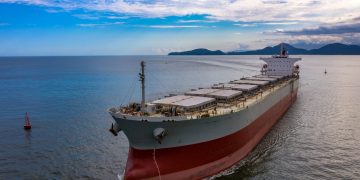DNV GL’s “Technology Outlook 2030” outlines future technologies and their impact on the shipping industry, focusing on how these technologies will affect various sectors. The report was launched by DNV GL – Maritime CEO Knut Ørbeck-Nilssen who further discussed the future of shipping based on the development of digitalization and decarbonization.
Mr Nilssen highlighted that
The decade ahead of us will be remembered as a turning point in history, with digitalization and decarbonization transforming how we live, how we work and what impact this has on the environment … The report has identified ten technology trends, and their associated risks, that will shape different industries and society up to 2030.
He added that the maritime industry is already experiencing the several changes coming from technology, as the environment is constantly evolving, and the market is still uncertain of the future.

Moreover, the report presents the ten technologies that will have the biggest impact on the shipping sector. In essence:
3 trends are classified as enabling-technologies which lay the base of profound technological change. These are:
- Acceleration of digitalization;
- Virtualization and automation across the lifecycle;
- Towards precision materials.
2 trends sustaining the biosphere:
- Engineering ecosystems;
- Wide use of ocean space.
5 trends that have been identified as transformative in key industries:
- Towards future transport and logistics;
- Towards low carbon energy systems;
- Harnessing health data for sustainable care;
- Towards precision food;
- The new space race.
Mr Ørbeck-Nilssen concluded that
These are just some of the technologies that are likely to impact the maritime world over the next ten years. The rate of change is staggering – and is not expected to slow down, rather to further accelerate. DNV GL will play an important role in helping the industry understand, manage and capitalize on new opportunities.
To explore more on the Technology Outlook 2030 click here.
































































